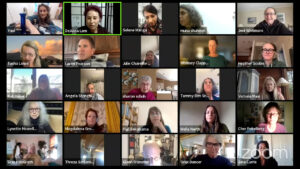 Have you ever thought of how many times you have cycled with the moon since the day of your first period? Lets do some quick math here: I started bleeding when I was 12, and I am 55 now. That is 43 years of cycling every month! (Yep, I’m still cycling…) Multiply 43 years by 13 cycles per year (there are 13 lunar cycles in a calendar year, and women cycle with the moon!) The answer is: get: 559!! Really?! It’s hard to imagine I had this many periods…
Have you ever thought of how many times you have cycled with the moon since the day of your first period? Lets do some quick math here: I started bleeding when I was 12, and I am 55 now. That is 43 years of cycling every month! (Yep, I’m still cycling…) Multiply 43 years by 13 cycles per year (there are 13 lunar cycles in a calendar year, and women cycle with the moon!) The answer is: get: 559!! Really?! It’s hard to imagine I had this many periods…
How about you? How old were you when you got your first period? Stop reading this article for just a moment and think about this: Your current age, minus the age you were when you started bleeding, gives you the number of years you have been cycling. Now multiply this number by 13, and you’ll get the number of periods you have had so far in your life. Surprising, isn’t it?
What other things do you do in your life this many times? If there are things you repeat as much, wouldn’t it be a topic of conversation? A theme of exploration, exchange, support? What else in your life do you do with such repetition? Sex, probably, yet we talk about sex, as a culture, interminably… There are talk shows, magazines, advise columns, therapists, healing modalities, support groups, forums, and whole industries devoted to sex, not to mention its feature status in day-to-day conversations.
Given the number of times we menstruate in our lives, the silence we keep about it is loud and clear. Its absence from cultural forums of discussion, and from casual daily conversations, breeds alone-ness and isolation among women worldwide. Each in the privacy of her own bathroom, women “deal” with their menstrual blood — quickly, quietly, and efficiently. There are no traces, no voice, no waves. It is as if this is an event so rare, so negligible, that it warrants no attention whatsoever!
For the abundance of this event in our lives to start reflecting it’s true presence, we need to start making menstruation visible! The dominant culture used to have hardly any art or public images of pregnancy and birth until recent years. This has been changing, thanks goodness, and public arenas are now openly and proudly showing birthing imagery, both photographed and artistically represented. It is up to us to create such a shift regarding Menstruation!
Start talking, start painting, start photographing! The image accompanying this article is a lovely example of what’s possible. It is only “shocking” to those who are not used to seeing menstrual blood on a monthly basis. And it is only “gross” to those who are treating it an an enemy rather than an ally.
Yes, our blood can become an ally! It’s a chicken-and-egg kind of a proposition, since you have to connect with your blood first, in order to become comfortable with it. Imagine your feelings toward a cousin you hardly ever see. You will obviously feel distant, and when you meet one another, once in a blue moon, there may be awkwardness and discomfort, which stem from lack of familiarity. Now imagine this cousin moving to live in your own neighborhood. Imagine seeing each other often, taking time to chat, sharing cups of tea and leisurely conversations. Wouldn’t this create a level of familiarity, comfort, and intimacy between you, which will make your time together relaxed, flowing, and full of ease? Well, it could be the same way with your menstrual blood! And the fact that it is already not only in your neighborhood, but inside your home, once every month – makes for a great start!
So, how many periods did YOU have?
I invite you to find out for yourself and to post in a comment below…
Lets make Menstruation Visible!




One Response
According to Wikipedia women in Japan, The Philippines, INdonesia, and Korea are entitled to Menstrual Leave (some at half pay). Read on: http://en.wikipedia.org/wiki/Menstrual_leave:
“The concept of menstrual leave started in Japan in the early 20th century. In the 1920s, Japanese labor unions started to demand leave (seiri kyuka) for their female workers. In 1947, a law was brought into force by the Japanese Labor Standards that allowed menstruating women to take days off work. Then a unique legislation of its kind, it is now found in a few countries. Debate continues as to whether it is a medical necessity or a discriminatory measure.
Changing times
Nike also included menstrual leave in their Code of Conduct in 2007, implemented around the globe wherever they operate. Nike obliges the business partners to follow the code principles by signing a Memorandum of Understanding. Australian Manufacturing Workers Union (AMWU) started a campaign for menstrual leave for female employees at Toyota. The union asked for 12 paid days of menstrual leave for a woman per year.
Laws in place
The Philippines government considered the House Bill 4888, known as the Menstruation Leave Act of 2008, which was initiated by the Alliance of Rural Concern (ARC) representative. The bill aimed to grant mandatory menstruation leave to all private and government female employees, except those pregnant and menopausal, at half pay.
In Indonesia, under the Labor Act of 1948, women have a right to two days of menstrual leave per month.
In Japan, according to the Article 68 of the Labour Standards Law, “When a woman for whom work during menstrual periods would be specially difficult has requested leave, the employer shall not employ such woman on days of the menstrual period.”
In Korea, not only are female employees entitled to menstrual leave according to the Article 71 of the Labour Standards Law,[11] but they are also ensured additional pay if they do not take the menstrual leave that they are entitled to.”
WHat do you think???